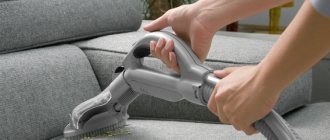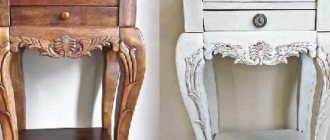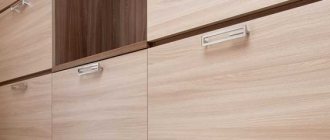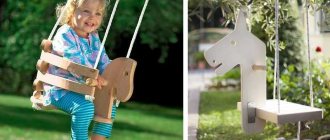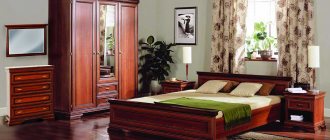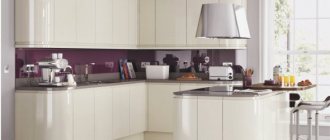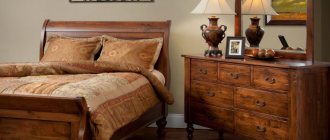Any buyer purchasing furniture hopes that it will last a long time and that the purchase will not disappoint him. Proper operation is a guarantee of long service.
To maintain the original appearance of furniture for many years, it needs to be looked after regularly. Cleaning furniture has its own characteristics. Maintenance isn't just about dusting. Each furniture element requires a personal approach.
Brief overview of the article
Types of furniture
Any material from which furniture is made has its own characteristics. This must be taken into account when operating and caring for it. Furniture in the kitchen, if the hood works properly, does not require any special care.
Standard methods are also suitable for furniture in the bedroom or living room. Caring for upholstered furniture is not at all difficult; it is only important to take into account the material when cleaning it and know a few simple rules.
Furniture operating rules
Acceptance of furniture
Upon receipt, it is recommended to check the furniture for completeness and external quality features.
You should open the packaging, inspect the front panels, mirrors, glass elements, check the presence and completeness of the fittings, and make sure there are no visible defects. It must be remembered that accepting furniture without indicating obvious defects that could have been discovered during a routine inspection deprives the buyer of the right to subsequently make claims for them.
In this case, the following are not considered a defect or defect in the furniture:
- the presence of certain features in its elements, due to the stylistic intent of the manufacturer in the selection of source materials or related to the natural origin of the materials used, with their insignificant differences in textures and/or shades.
- slight difference in color shades of facing fabrics, as well as coverings made of artificial and natural leather.
- slight difference in color shades and differences in paint and/or decorative patterns.
- folds and wrinkles on upholstery materials of soft elements that arise due to stress as a result of packaging and/or during transportation, and disappear after smoothing by hand, are also not a defect.
Permissible deviations in the parameters of the materials used and technological parameters in the production of furniture are regulated by Interstate Standards (GOST 16371-2014, GOST 19917-2014).
General rules for the use and care of wooden furniture
Each piece of furniture should be used only according to its direct functional purpose. The service life of furniture made from natural materials and the preservation of the attractive appearance of furniture throughout the entire period of operation largely depend on the conditions of its use.
It is very important for the owner of wooden furniture to understand how significantly the climatic conditions of the environment (in the room of use) can affect the appearance and quality characteristics of furniture made of solid oak, beech, birch, pine, etc. Since wood furniture products are sensitive to light, humidity, and temperature, it is recommended to avoid prolonged exposure to one or more of these parameters outside the permissible values. Otherwise, this may cause premature aging of the paintwork, warping, cracking and deformation of wooden furniture elements, and accelerated aging of the upholstery material. The most negative consequences for natural furniture can be caused by sharp changes in these climatic characteristics.
To keep solid wood furniture in the best condition for a long time, you must follow certain rules of operation and care.
- Avoid prolonged exposure to direct sunlight, which may cause discoloration on wooden furniture surfaces or upholstery material.
- Furniture products should be used in dry, warm rooms (from +10º C to +40º C), with a recommended relative humidity of 60%-70%, without sudden temperature changes, at a distance of no closer than 1 m from heat sources. If necessary, ventilate the room more often and use dehumidifiers or humidifiers.
- Make sure that the furniture is completely dry. The surfaces of furniture parts should be protected from prolonged exposure to moisture to avoid swelling of body parts, facades and tabletops, and peeling of edges. Liquids that dissolve paint coatings (alcohol, acetone, gasoline, etc.) are not allowed to come into contact with varnish surfaces. It is recommended to clean any part of the furniture immediately after it has become dirty. If soiling is left for some time, the risk of residual stains increases significantly and the risk of damage in areas where furniture is soiled increases significantly.
- When caring for furniture, the use of chemically active substances, abrasive compounds and aggressive liquids is not permissible. In case of persistent contamination, special products with cleaning and protective properties should be used. In other cases, it is enough to wipe the furniture with a dry or damp soft cloth.
- Furniture surfaces should be protected from mechanical damage from heavy, hard or sharp objects. Do not allow hot objects to come into contact with furniture.
Features of the use of cabinet furniture
Each piece of cabinet furniture, be it a cabinet, chest of drawers, wardrobe, hallway, modular kitchen element, table, etc., must be used strictly in accordance with its functional purpose.
- Never move a piece of cabinet furniture by lifting or pulling it by the tabletop. If you need to move the product, lift or move it, applying force only to the supporting elements of its structure (body, legs, etc.).
- Doors and drawers of furniture products must be kept closed and not use too much physical effort to open them. Stable operation of the hinges and the absence of distortions of the guides is ensured by correct adjustment during the assembly and installation of the furniture product, as well as periodic preventive checks and adjustments, if necessary, during the operation of cabinet furniture.
- All things should be placed inside the cabinets in such a way as to obtain the most even distribution of the load along the entire length of the telescopic rod, over the entire available area of the drawer, thereby ensuring the necessary balance of the load on the hangers and sliding parts of the guides. It is recommended to place things on telescopic rods and shelves according to the following principle: the heaviest ones are closer to the edges (supports), the lighter ones are closer to the center. It is recommended to load tall cabinets and columns more in the lower compartments to ensure their better stability.
- For the safe operation of some tall pieces of furniture (hallways, libraries), the depth of which is less than 45 cm, they require fastening to the wall. It is also necessary to pay attention to the fact that some furniture models do not have a cutout for the baseboard. It is not recommended to move some cabinet furniture in assembled form, as this can lead to its destruction, so the installation of such furniture is usually carried out in a strictly defined place, which should not change during operation.
- When using cabinet furniture, the following restrictions on vertical static load apply:
- on the bottom of a drawer at one point - no more than 5 kg, in total for the entire drawer - no more than 10 kg;
- on a glass shelf at one point - no more than 5 kg, in total on the entire glass shelf - no more than 10 kg;
- on a tabletop (dressers and cabinets) at one point - no more than 20 kg, in total on the entire tabletop - more than 50 kg.
on a chipboard/MDF shelf at one point - no more than 10 kg, in total on the entire shelf - no more than 20 kg;
Care of surfaces of parts made of solid wood and covered with natural wood veneer
No less important role than the climatic parameters of operation in preserving the appearance of wooden surfaces is played by measures taken to care for them on the part of the owner. The most important procedures for caring for such surfaces are systematic cleaning and treatment of furniture surfaces made of solid wood and wood veneer with special compounds.
For cleaning, it is recommended to use a soft cloth, pre-moistened and wrung out well before use. After cleaning, the wetted areas of the surfaces must be thoroughly dried by wiping with a dry and soft cloth. A completely suitable alternative method is dry cleaning using a vacuum cleaner with a soft brush attachment.
As a special composition for treating wooden surfaces after cleaning, it is recommended to use various wood polishes. However, polishes and other household chemical products cannot be used to treat kitchen furniture, the instructions for use of which indicate their negative impact if they come into contact with food products.
Care of varnished surfaces
It should be remembered that varnished surfaces may change appearance over time, not only depending on the degree of deviation from the recommended ranges of environmental parameters such as temperature and humidity, quality of care, but also depending on the degree of exposure to sunlight.
For cleaning, it is strongly recommended to use a dry soft cloth and apply specially designed cleaners that also have polishing properties. It is possible to use special polishes for varnished furniture surfaces, which at the same time have cleaning properties. However, to treat varnished surfaces of kitchen furniture, you cannot use polishes and other household chemical products, the instructions for use of which indicate their negative impact if they come into contact with food products.
Care of glass surfaces
Taking into account the fragility of glass, care and caution should be exercised during the operation and care of glass products. To clean glass, special products are used, which are widely represented among the entire range of household cleaners and detergents.
When cleaning, do not use products or sponges that have abrasive properties. In addition to this, glass and mirror surfaces with a decorative pattern applied should be cleaned extremely carefully using products that do not contain aggressive components, as this can lead to partial or complete erasing of the pattern.
Operation of electrical appliances as part of cabinet furniture
The operation and care of electrical household appliances and components included in the furniture product must be carried out in accordance with the relevant instructions contained in the operating manuals of the manufacturers of these electrical appliances.
Furniture for sitting and lying. Features of operation and care.
All furniture products for sitting and lying, such as sofas, armchairs, beds, sofa beds, chair beds, ottomans, banquettes, chairs, stools, etc., are intended exclusively for sitting and lying.
The use of these furniture products for other purposes, as well as exceeding the permissible loads on these products, contributes to excessive wear of the furniture and can lead to the premature loss of its important performance qualities. To avoid accidents and damage to furniture, it is not recommended to jump on beds and sofas, stand on them, sit on armrests and backrests, swing on chairs, etc.
Sofa beds with folding mechanisms intended for guest occupancy should not be used as a daily sleeping place, as this can significantly reduce the life of this furniture.
To maintain the proper appearance of furniture with soft elements, it is necessary to carefully and carefully handle the upholstery and properly care for it. Genuine leather upholstery should be regularly wiped from dust with a soft damp cloth and treated with a special leather product twice a year. It must be remembered that natural leather does not like direct sunlight and high temperatures. Do not use abrasive cleaners or solvents to clean leather. Leather furniture should not be placed in hot rooms with low humidity, otherwise the leather will dry out, become brittle and become unusable. To clean upholstery fabric from dust, it is recommended to use a vacuum cleaner with special furniture attachments. Dust can also be removed using a soft brush. Any significant contamination should be removed immediately using special cleaning agents depending on the type of fabric, guided on the one hand by the care instructions of the manufacturer of this furniture, and on the other hand by the instructions for use of the manufacturer of the cleaning agent. If your furniture has removable covers, it is recommended to use dry cleaning services to remove stains. In any case, to prevent the formation of stains on furniture, the use of water to combat various types of contamination should be limited.
Caring for wooden elements of furniture for sitting and lying should be carried out following the rules and recommendations for caring for the surfaces of cabinet furniture parts made of solid wood or covered with natural wood veneer (see above).
Maintenance during operation of cabinet and upholstered furniture
After a certain period of using furniture under load, a situation may arise when some mechanical parts, such as hinges, guides, locks, etc., lose the optimal settings made during assembly and installation of the furniture. The lubricant of mechanical components dries out over time and loses its properties. Similar phenomena manifest themselves in difficulty opening doors or pulling out drawers, sofa folding mechanisms, or creaking. In such cases, you should not apply excessive physical effort, but it is necessary to timely adjust the hinges or lubricate the moving parts of the mechanisms with special lubricants. During the operation of furniture, threaded connections should be periodically tightened.
Wooden furniture
Rules for caring for wooden furniture include protecting it from insects. For prevention, every spring the lower part of the furniture is rubbed with turpentine. Using a cloth moistened with vegetable oil, you can refresh the surfaces.
An eraser will help remove stains from varnished surfaces. Traces of scratches are rubbed with walnut, then polished with cloth. Instead of a walnut, you can use wax or a paraffin candle. If mold appears somewhere due to dampness, remove it with a sponge soaked in gasoline. Iodine will help deal with scratches on mahogany.
How to care for furniture made of natural wood of different types?
Attractive and environmentally friendly natural materials are finicky and capricious. They do not tolerate direct sunlight and bright lighting; they require comfortable conditions and careful handling. Wooden furniture must be protected from careless shocks, impacts, and cuts. It must be installed on a flat floor to prevent the structure from skewing.
It is better to wipe countertops and shelves in the direction of the wood grain, and then dust particles will not clog into the pores. Varnished and polished surfaces are highly electrified and require the use of antistatic agents.
To find out exactly how to care for furniture made from solid wood of a certain species, it is worth determining the type of wood:
- mahogany is rubbed with vegetable oil;
- It is recommended to clean oak with warm beer with wax and sugar;
- the nut can be tidied up with red wine;
- For light varieties, milk or cream is used.
To maintain the quality of products, the temperature in the room should be kept within 10-25 °C, and the humidity level should be in the range of 45-70%. Excessive dryness and heat lead to loss of natural moisture, causing parts to shrink and crack.
Collections of tips on how to care for solid wood furniture recommend opening windows more often, installing humidifiers, aquariums, and indoor fountains.
With increased humidity, the body swells, adhesives, protective impregnations, varnishes and paints lose their properties. Mold deposits may appear on surfaces, and grinder beetles may settle inside the wood.
The presence of pests is indicated by the following signs:
- Lots of small round holes.
- Brown powdery substance.
- Monotonous sounds reminiscent of the passage of a clock.
You can get rid of insects using special solutions.
Matte surfaces
In case of serious contamination, you can wash with soap and water and immediately wipe well with a dry cloth. Do not use polish, otherwise it will leave greasy stains on the surface.
- 100 g water;
- 30 g of ammonia;
- 15 g chalk or tooth powder.
The powder is first dissolved in half a glass of water, ammonia is added and mixed thoroughly. The resulting white slurry is applied to metal elements, allowed to dry for 20-30 minutes, then rubbed with a cloth.
Caring for unpolished and matte furniture at home
When caring for unpolished furniture, it should be wiped with a dry soft cloth or treated with special attachments for a vacuum cleaner. In case of heavy contamination, you can remove dust and dirt from the furniture with a damp cloth, but be sure to wipe the surface of the furniture dry afterwards.
When caring for unpolished furniture at home, it can be renewed using a specially prepared composition. Place the finely planed wax in a glass jar and fill it 2/3 full with turpentine. Place the jar in a short metal bowl filled with very hot water. When the wax is completely melted, you need to mix the mass well.
Before treating with this composition, you should wipe the entire surface with a cloth soaked in warm soapy water, then with a clean damp cloth and wipe dry. Then apply a mixture of turpentine and wax, distributing the mixture evenly in a thin layer. The mixture should be left on the furniture for 24-36 hours, then thoroughly rubbed and polished with a woolen cloth or a piece of felt.
It happens that unpolished furniture lined with valuable wood develops swellings that spoil its appearance. This problem can be helped by caring for matte furniture, removing bubbles with a hot iron. This is done like this: apply 3-4 sheets of white thick paper to the surface of the furniture and iron the swollen area through the paper. If this does not work, you can carefully puncture the bubble with a sharp, thin instrument and pour a little glue into the resulting hole. After this, iron the damaged area of furniture again with a hot iron through several layers of paper.
However, this method is not suitable for polished furniture. If the polish is damaged, you should contact a furniture specialist to repair it.
We often use straw furniture to create the interior of balconies or loggias, and kitchen areas. However, in such rooms the most dust, soot, and fumes from a gas stove and various household appliances accumulate. Straw furniture gets dirty very quickly and requires cleaning. It can be cleaned quite well with a brush dipped in a strong solution of table salt. This returns it to its original light color.
If straw furniture begins to turn yellow over time, it can be bleached a little by wiping it with a cloth generously moistened with a not very strong solution of potassium permanganate (a few crystals of potassium permanganate per 1 glass of warm water). After cleaning, the furniture should be wiped with a clean damp cloth and dried thoroughly.
Heavily soiled straw furniture can be carefully washed with moderately hot water in which a small amount of washing powder or laundry soap is dissolved. Then the straw is washed with clean water using a rag and dried well.
Cushioned furniture
In addition to periodic vacuuming, upholstered furniture also needs additional care. To remove stains, a soap solution, a sponge and clean napkins are suitable.
Apply detergent to grease stains and leave for half an hour. Then they are brushed and wiped with a damp cloth. Stains from lipstick, juice, and wine can be wiped off with vodka. Traces of coffee and chocolate - soap foam. Since you need to take care of upholstered furniture with special care, it is important to take into account the features of its coating.
Types of furniture and care for it
Quite conventionally, furniture can be divided into the following types, depending on the material from which a particular set is made: chipboard, MDF, natural wood. Each material has its own characteristics, which must be taken into account both at the selection and design stage, and throughout its entire service life.
Caring for kitchen furniture with a high-quality hood will not be difficult. In the bedroom, living room and hallway it is easy to get by with standard measures. Properly caring for upholstered furniture will also not be difficult, except that the care will be slightly different based on the material (velor, leather, eco-leather) and operating conditions (for example, whether there are children or pets in the house).
Caring for chipboard furniture
It is a common belief that particle boards are afraid of moisture. This is true, so when purchasing products made from this material, pay attention to the quality of surface treatment. Namely: all ends must be seamlessly edged (covered with an edge). Only this condition guarantees a long service life of the panels. Of course, if you pour water on furniture, nothing good will come of it. But a reliable coating will retain moisture on its surface for the time it takes to collect it.
Caring for natural wood furniture
Caring for solid wood furniture will require more effort from you than any other material. Natural materials are capricious. They do not tolerate high/low humidity and temperature and should be protected from direct sunlight (to avoid fading). Therefore, if you dare to purchase a cabinet that is made of natural wood species, then be prepared to constantly maintain the temperature and humidity conditions in the room (humidity 65%, temperature not lower than +15 C). Cleaning with delicate detergents and wax-based preparations (gentle care) is acceptable.
Mr.Doors uses only partial solid wood for its collections, thanks to this you get a result that not only visually meets your requirements, but also does not require exclusive care.
Caring for polished furniture at home
As a rule, fingerprints and splashes are easily visible on shiny surfaces. Therefore, you will have to wipe the varnished surface with a dry (NOT wet! - streaks will remain) felt or flannel cloth quite often. The best solution for removing stains is water with a small amount of ammonia (6/1 ratio).
Caring for white MDF furniture
MDF differs from other materials in its increased moisture resistance. It can be safely used even for bathrooms. Recommendation: pay attention to the quality of the coating - it must be perfectly smooth and seamless. To remove dust, use a soft, dry cloth. With white and glossy furniture, these manipulations will have to be done more often, because on white every speck of dust is clearly visible.
There are no special rules for caring for dark matte furniture. As you may have noticed, it all depends on the material from which it is made.
We invite you to visit the nearest Mr.Doors furniture studio, where they will not only help you choose the material for your future set, but will also tell you in more detail about how to care for furniture made from it.
Author: Natalya Pavlova
Flock
Care is carried out exclusively with products with a neutral environment. It is strictly not recommended to use organic solvents for this. Dry cleaning is contraindicated. Stains are removed gently using a warm soap solution and a soft sponge.
Serious stains are removed with special water-based furniture care products. It is allowed to use a 10% alcohol solution.
To make furniture last a long time: care recommendations
Artefacto loves furniture very much and wishes it all the best. Even when we leave it in the good hands of our clients, we want to continue to take care of it. At least with the help of a care instruction, in which we have collected useful recommendations to help preserve the original appearance of leather armchairs, rosewood tables and metal chairs.
Solid wood furniture
Any wooden furniture should not be very close to heating and heating appliances. The room in which it is located must be periodically ventilated and its humidity maintained at 45-60%. However, this level of humidity is optimal not only for furniture, but also for human health. Both varnished and unvarnished furniture does not like when hot objects are placed on it and cleaned with aggressive chemical compounds.
Tip: When wiping wooden furniture, move in the direction of the wood grain - otherwise you risk rubbing dust into the pores of the wood.
Teak furniture Teak is the most durable wood. She doesn’t care about moisture, insects, temperature changes, or microorganisms. However, like any superhero, she also has weaknesses. Doesn't like teak furniture:
- direct sunlight,
- bleaching detergents (only specialized ones are suitable),
- care products for plastic and painted surfaces,
- fuels and lubricants.
The rules for caring for teak furniture are simple - it should be washed regularly with a soft-bristled brush and a weak soap solution. To brighten the color and protect the surface from stains, you can use teak oil (a mixture of flax and special solvents). It is applied approximately once every 4-6 months.
Teak furniture also serves well outdoors. However, it must be treated with oil or special impregnation. It is advisable to repeat this procedure once a year.
If there is a deep stain on teak furniture that cannot be cleaned with a brush, you can resort to special cleaning products (like Teak Cleaner) or use fine-grit sandpaper. Also, stains on teak furniture are easily removed with oxalic acid.
Rosewood furniture Rosewood is one of the most expensive materials from which musical instruments, luxury furniture, and interior lining of yachts have long been made. Its main advantage is its luxurious appearance, with a pronounced pattern and a rich color palette. But craftsmen love it not only for this, but also for the compounds it contains that repel insects and protect the finished product from external influences.
Rosewood, like teak, does not tolerate sunlight, and in the air over time it changes its color to a darker one. Rosewood furniture is not intended for gardens or terraces, as it does not like humidity. The rules for caring for her are simple but strict:
- protection from direct sunlight;
- refusal of chemical cleaning products except special ones;
- products based on natural ingredients (beeswax, olive and linseed oil), on the contrary, are welcome;
Furniture made from mango Mango is a wood that can be processed well, withstands high humidity well and is easily recognized by its light color, full of inclusions of various shades - from pink to greenish. Like many other exotic woods, mango does not respond well to direct sunlight and does not like excessive dryness. In addition, the porous structure of mango quickly absorbs water, so it is better to clean furniture made from this wood using a dry method. To increase the service life of mango furniture, it is recommended to coat it with wax or other protective agents suitable for tropical types of wood.
Metal furniture
The main enemy of metal furniture is rust. To avoid this, high levels of humidity should not be allowed in the room where metal products are located. In addition, the metal should be periodically impregnated with anti-corrosion agents.
Advice: If traces of rust have already appeared, the problem area should be primed and painted over in order to avoid the spread of corrosion.
You can clean metal only with soft sponges and gel or liquid cleaning agents. Depending on the type of metal, the composition of the cleaning agent may vary. Since Artefacto mainly presents furniture and interior items made of brass, zinc and cast iron, we will separately note these metals:
Brass: not resistant to soluble acids and strong alkalis. For cleaning, you can use stainless steel cleaners. Zinc: does not tolerate alkaline cleaners with a pH above 12-13 and abrasive cleaners. To care for it, you should choose plastic and nylon brushes and soap solution. Cast iron: can be cleaned with light abrasives and neutral cleaners;
Galvanized metals (plating applied through electrolysis, such as the Marble Top collection) should be cleaned with the mildest abrasive liquid cleaners.
Cushioned furniture
Upholstered furniture should not be placed closer than 40 cm from heat sources, and should not be used in rooms where the temperature drops below +10C and the humidity exceeds 70%. The rules for caring for upholstered furniture are simple: regular vacuuming, which can be completed by lightly wiping the furniture with a damp cloth.
Tip: If a stain appears on the furniture, do not rub it too hard. Using a sponge soaked in a mild soap solution, remove the stain in a circular motion from the center to the edges.
Leather furniture
To prevent leather furniture from drying out and cracking, you can use a natural air humidifier in the room in the form of an aquarium or living plants, or use special devices. Leather furniture should be protected from direct sunlight and kept away from heating devices. Furniture made from genuine leather also requires regular cleaning with a vacuum cleaner and a thoroughly wrung-out damp cloth. If water gets on your skin, you should quickly blot it and leave it to air dry. Using, for example, a hair dryer is strictly not recommended. To remove stains from leather products, you should not use solvents or stain removers; it would be better to acquire special leather cleaning products.
Tip: It is better not to lay colored blankets and pillows on leather sofas and armchairs. Genuine leather absorbs dyes well, and if it turns out that some textile element is fading, a stain will easily remain on it, which will be quite difficult to remove.
Chenille
This material does not tolerate contact with water. It is better to entrust the removable cover to dry cleaning. Methyl alcohol (2 tablespoons per 1 liter of water) will help you remove stains on your own. Instead of alcohol, you can use table vinegar. After the procedure, moisture should be blotted thoroughly and dried with a warm iron.
We recommend reading:
- DIY table: review of the finished drawing, assembly diagram, choice of material and dimensions (98 photo ideas)
Do-it-yourself upholstery of upholstered furniture: photos of ready-made options and examples of modern design
- Do-it-yourself upholstery (upholstery) of chairs: 100 photos of ready-made options and unusual designs
2.Furniture care rules
Attention!!! When choosing a cleaning product, you must read the instructions for its use or consult with specialists from specialized enterprises (dry cleaning, etc.).
- do not try to scrape off dried stains or stuck together pile of material;
- Before cleaning, try the product on a sample of upholstery fabric or a small, inconspicuous area and allow it to dry. If the color or texture of the furniture has changed, use a different product;
- never apply stain remover directly to the surface of the furniture covering; cover decorative elements close to the stain;
- in order not to disturb the structure of the furniture coating, the stain remover should be applied without rubbing into the surface;
Recommendations for removing contaminants:
| Type of pollution | Action |
| Candle wax | Crush, scrape and vacuum up. Cover the remaining stain with blotting paper and iron. |
| Chocolate | Clean the dried stain and wash with warm water and mild soap, drying off excess moisture. |
| Coffee | Wash the wet cloth with mild soap and dry off any excess moisture. |
| Chewing gum | Cover the gum with ice cubes (in a plastic bag) and scrape with a blunt object. |
| Blood | Remove stain with cold water. |
| Red wine | Blot the liquid immediately. Sprinkle salt on the wet spot. After the salt has absorbed the wine and the stain has dried, brush or vacuum. |
| Beer | Wash the wet cloth with mild soap and dry off any excess moisture. Then apply a vinegar solution (2 tablespoons per 1 liter of water). Dry off excess moisture, rinse with clean water and dry. |
2.2.Care for natural and artificial leather.
Routine care is limited primarily to wiping leather furniture with a damp suede cloth. To clean the leather, use a separate suede cloth that is free of soap residues. Remove spilled liquid with a cotton cloth, then blot the area with suede.
Attention! Avoid strong sunlight and close contact with heat sources.
Attention! The skin stretches. The folds that appear as a result of use emphasize the natural attractiveness of your furniture.
MAXIMUM LOADS ON TRANSFORMATION MECHANISMS
Name of mechanism – Permissible load (kg)* per bed
- Eurobook 180-200 (2 people)
- Tick-tock 180-200 (2 people)
- Dolphin 160-170 (2 persons)
- Accordion 160-170 (2 persons)
- Telescope 160 (2 persons)
- Reversible 70 (1 person)
- Book 160 (2 people)
- Click-clack 150 (2 people)
- Transformer 160-170 (2 persons)
- French folding bed 120-130 (2 persons)**
- Sedaflex 140-150 (2 people)
- Roll-out cot 140-150 (2 persons)**
- Puma 160-170 (2 persons)
*static, evenly distributed load
**These transformation mechanisms are not intended for daily use (guest version).
DRAW YOUR ATTENTION TO!
Any upholstered furniture is intended for comfortable use by the consumer whose weight does not exceed 110 kg!
Attention! The linen box is intended only for storing bedding.
Velours
This is a beautiful, but very delicate and fragile coating. The fabric does not tolerate contact with aggressive substances - solvents and other products containing petroleum products. It is not recommended to wring it out or bleach it.
Remove dirt using a sponge and a warm solution of soap and water. It is allowed to use special water-based products.
Genuine Leather
Caring for leather furniture has its own characteristics. This is an expensive coating, so the cleaning process must be approached with caution. Dust is removed with a damp flannel cloth. Traces of a felt-tip pen, lipstick, coffee or wine are erased with a damp alcohol swab, after which the treated area is rubbed with stearin (greased).
In the room where leather-covered furniture is located, the humidity should be at least 65%. If the air is drier, the skin begins to dry out and crack. Maintaining the fat balance in the skin is possible by periodically rubbing it with stearic lubricant, which is applied with a sponge.
We recommend reading:
- Do-it-yourself furniture decoupage: review of the best techniques, original ideas and beautiful design (140 photos)
How to update furniture with your own hands - a review of the best ideas for beautiful restoration of home furniture (120 photo ideas)
How to make a sofa with your own hands: diagrams, photos, drawings, dimensions + design ideas
Kitchen furniture
Most kitchen furniture is made from chipboard. This material is very easy to clean. It can be washed in any way, but be careful. Water should not get into the places where the fittings are fastened and into the joints. Excess moisture can cause the veneer to peel off, and the material itself can swell and become deformed.
Glossy surfaces are more difficult to care for. Solvents, alkalis, and acids should not come into contact with them. Cleaning with abrasive substances is also contraindicated.
Traditional methods and home recipes
When there were no household chemicals yet, our ancestors knew how to care for wooden furniture using improvised means. Over time, the treasury of knowledge has been replenished with the secrets of modern housewives.
- Dried splashes are removed with a mixture of vegetable oil and vinegar.
- Drops of iodine and fingerprints are eliminated by raw potatoes.
- Stains from wet dishes on polishing are wiped with a walnut.
- Kerosene erases the remains of flies.
- Gasoline kills mold.
- Cabbage brine removes old stains.
- A cup of coffee grounds inside the cabinet eliminates unpleasant odors.
Natural materials
Granite, marble and other similar materials need to be treated with water-repellent agents, which form a protective layer on the surface.
Caring for furniture at home is not such a difficult process. If you regularly set aside a little time for this, your furniture will retain its original appearance for a long time and will harmoniously maintain the comfort of your home.
Caring for lacquered and painted furniture
Paint and varnish coating is one of the best options for the facades of modern furniture. It is this coating that gives the furniture its gloss. Modern manufacturers produce painted facades from MDF, but previously they used the same technology to varnish cabinets, tables and other furniture. There are a number of tips for caring for a glossy surface using all kinds of oils, glycerin, alcohol, milk, salt, nuts, etc.
When caring for varnished and painted furniture, you must adhere to a number of rules. For example, you should avoid overheating, so painted furniture should not be placed near heating appliances, or on heated floors. You should also not place hot objects on such furniture. Cold walls should also be avoided. If you want your furniture to serve you for as long as possible, then you should not allow the varnished surface to be exposed to direct sunlight for a long time.
Read Wallpaper based on serpyanka
In order to avoid mechanical damage, it is necessary to handle sharp and heavy objects carefully. There should be no drops of oil or other contaminants on the surface of varnished or painted furniture.
It is best to wipe painted or varnished furniture with a soft cloth. The use of powder cleaning agents and aggressive agents is not recommended. But you can easily use non-aggressive detergents or soap solution when caring for such surfaces. If you use detergents, be sure to remove them from the surface. You should not leave such products to dry on the surface of the furniture. Wipe everything dry, otherwise whitish spots may remain on the varnished surface. It is best to use a flannel cloth for wiping. You can also use microfiber or faux suede car wipes. If your lacquered furniture is old or has become dull, then you need polishing. For this purpose, polishes are used for furniture facades or glossy surfaces.

